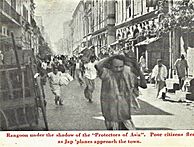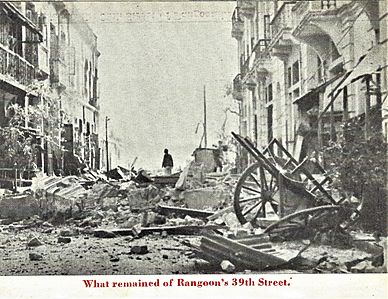Bombing of Rangoon in World War II facts for kids
Quick facts for kids Bombing of Rangoon |
|||||
|---|---|---|---|---|---|
| Part of Pacific War | |||||
|
|||||
| Belligerents | |||||
The bombing of Rangoon was a series of air raids by the Imperial Japanese Army Air Service. These attacks happened between December 1941 and March 1942. They were part of the Burma Campaign during World War II.
Rangoon, the capital city of British Burma, was the first place attacked. Japan started these air raids to prepare for its invasion of Burma. This happened just weeks after Japan declared war on the United States and the United Kingdom on December 8, 1941.
Contents
December 23, 1941: The First Big Attack
Why Rangoon Was Attacked
The war in southern Burma was about to change a lot. Japan planned major air raids to get ready for its invasion. General Michio Sugawara planned a big bombing raid on Rangoon for December 23.
The main targets were the Mingaladon airfield and the city center of Rangoon. The famous Shwedagon Pagoda was an easy landmark for pilots to see from the air. The Japanese wanted to bomb city areas to scare people. They hoped this would make people lose their will to fight and turn against the British leaders.
Japan had 80 bombers and 30 fighter planes ready for this mission. Most of the bombers were fast, modern Mitsubishi Ki-21 planes. Three groups of these bombers would be supported by nimble Nakajima Ki-27 fighters. They also had Mitsubishi Ki-30 light bombers. These planes carried a 600-pound bomb and had machine guns.
The Attack Begins
Japanese planes took off from airfields in Thailand and Indochina on the morning of December 23. When they reached Rangoon, the sky was clear, making it easy to see their targets. Just before 10 a.m., the control room at Mingaladon reported two groups of enemy planes coming.
Fighter planes from the base were quickly sent up to stop them. A dozen Curtiss Tomahawks and fifteen Brewster Buffaloes from the Royal Air Force and the American Volunteer Group (AVG) took off. They climbed as high as they could. The Japanese planes arrived about 40 minutes after the first warning.
One group of Japanese bombers headed for Mingaladon airfield. Slower fighter-bombers and fighters followed them. Two other groups of bombers flew towards Rangoon city in a separate stream.
A couple of Buffaloes already in the air were the first to attack the bombers going to Mingaladon. Soon, a group of Tomahawks gained enough height to join the fight. They flew behind the bombers, then peeled off to shoot them with machine guns. More Tomahawks joined. Pilot Chuck Older forced one bomber out of its formation, trailing smoke. Another bomber crashed near the waterfront.
However, the Japanese also fought back. AVG pilot Hank Gilbert's Tomahawk was shot down by the bombers' guns. Gilbert was the AVG's first combat death. Paul Greene had to parachute out when his plane went out of control. He was knocked out when he landed but woke up to find a British soldier pointing a gun at him.
The Japanese bomber group that attacked Mingaladon lost five out of fifteen bombers. All their other bombers were also damaged. Meanwhile, two more groups of Japanese bombers flew towards the center of Rangoon. Six Tomahawks were circling over Syriam, watching for more planes.
They soon saw a well-organized group of green-camouflaged bombers flying at 17,000 feet. This group had eighteen bombers. The Tomahawks attacked in two groups of three planes. One Tomahawk was damaged, and its pilot was killed by the bombers' gunners. Two Japanese bombers were shot down by the American fighters. Three crew members parachuted out of one bomber. The body of a Japanese airman was later found with a grenade in his hand. Several other bombers were damaged. The commander of the Japanese group was killed by machine-gun fire.
Despite these losses, the Japanese bombers caused a lot of damage. The bombers hit Mingaladon airfield, damaging planes, the control room, a hangar, and fuel tanks. At the same time, other Japanese bombers focused on the city's downtown areas. Allied planes stopped less than 10 of these bombers. Twenty minutes later, 27 more Japanese bombers dropped bombs on the city center with little resistance and then flew home.
Powerful bombs and fire bombs destroyed over three-fifths of the wooden buildings. Many people lost their lives. Flying glass and collapsing houses caused a panic. People ran, trampling those who fell. An Indian shopkeeper said it was sad to see women and children crying and running in fear. Children clung to strangers, thinking they were their parents.
What Happened After the Attack
Japanese records show that seven bombers were shot down on December 23. Another bomber crashed on its way back. Japanese pilots often claimed to have shot down many Allied fighters, but these claims were often too high. The Allied forces lost four Tomahawks, and two pilots were killed. No Buffaloes were lost.
Seventeen Allied military people were killed at Mingaladon airfield. An estimated 1,000 to 2,000 civilians died in the city's downtown areas. The docks stopped working because many workers fled the city. Public transport also stopped. An area near the main docks was burned down. Smoke rose into the sky over Rangoon.
The city's emergency services struggled because many staff members fled. However, the firefighters did a good job during the crisis. The attack shocked everyone and caused many people to flee. Many ran into the nearby jungles, and some headed north towards Prome to find safety from Japanese air attacks. The Governor, Dorman-Smith, toured the city that afternoon. Many people who had died were still uncollected in the hot climate.
December 25, 1941: Christmas Day Attack
Planning the Next Attack
The Japanese commander, Sugawara, was angry about the bombers his forces lost. He decided to attack Rangoon again on December 24. However, he didn't have enough planes and equipment ready for another attack so soon. So, he delayed the next attack until Christmas Day, December 25.




